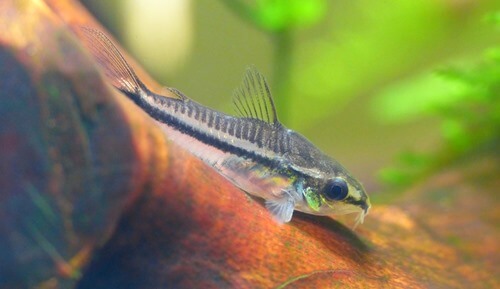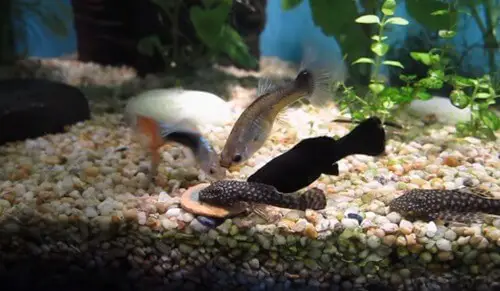Products recommended in this post contain affiliate links. If you buy something through our posts, we may receive a commission at no extra charge to you. See our full disclosures here.
Maintaining the health of your aquarium fish is not difficult as long as you take a few precautions. Offering your fish a healthy diet and keeping your tank clean will go a long way toward preserving the health of your fish. You should also make sure to perform regular water changes to keep the water quality in your tank high and regularly switch out your filter media so your filtration system operates at maximum capacity. Below you will find an overview of the factors influencing the health of your aquarium fish as well as tips for dealing with freshwater fish diseases.
Factors influencing aquarium fish health
For the most part, disease in the home aquarium is fairly rare. While certain types of bacteria may be present in most tanks, it isn’t until the immune systems of your fish become compromised by stress or injury that those bacteria will cause a problem. The most common cause of disease in freshwater aquariums is the introduction of new fish to the tank without putting them through a 2-week quarantine period. When you buy new fish, you have no way of knowing which diseases they may have been exposed to. Even if the fish do not show any signs of illness, you should take the precaution of quarantining them for 2 weeks before adding them to your tank.

When it comes to maintaining the health and wellness of your aquarium fish, there are a number of factors that come into play. Not only do you need to offer your fish a healthy diet, but you need to make sure that the tank environment meets their needs as well. You will find a list of factors that influence the health of your aquarium fish below:
Diet
Aquarium fish require a balance of macronutrients and micronutrients in their diet to facilitate not only healthy growth but good overall health as well. Nutritional deficiencies may have a negative impact on the immune systems of your fish, leaving them more susceptible to disease.
Tank Size
For your fish, their tank is their world – it is the only environment they will ever know so if it doesn’t not meet their needs, your fish will not be healthy. Tank size plays a key role in aquarium fish health because if the tank is too small or overcrowded your fish will become stressed and, as a result, they may be more susceptible to disease. A 20 gallon fish tank with freshwater fish is strongly recommended for a beginner because this tank size is large enough to maintain easily.

Water Parameters
Different species of fish have different requirements in terms of water parameters, but if your tank does not meet those needs then your fish will not be healthy. For example, aquarium fish rely on the temperature of their environment to regulate their body temperature and to maintain healthy metabolic function. If the temperature in your tank is too high or too low, your fish may fail to thrive.
Water Chemistry
Just as aquarium fish have specific requirements for water temperature and other water parameters – they also have specific needs for water chemistry. Different species have different needs for the pH of tank water as well as the water hardness and alkalinity. If these parameters are not met, your fish could become stressed.
Water Quality
The quality of your tank water may be the most important factor influencing the health of your aquarium fish. If there are too many fish in your tank or you do not perform routine water changes, the water quality in your tank will drop and your fish will become stressed as a result. Poor water quality could result in low levels of dissolved oxygen, high levels of ammonia, and other factors which could cause your fish to become stressed or kill them outright.
What to do when your fish seem disease
Unfortunately, aquarium fish cannot come out and tell you when they are feeling sick so it is up to you to identify the symptoms. As a responsible aquarium hobbyist, you should spend a few minutes each day observing your fish. This will help you to get a feel for the normal behavior of your fish so you will be better able to identify any changes in behavior. If, for example, one of your fish tends to be very active and it suddenly starts to hide near the bottom of the tank and doesn’t even come out for meals, there is a good chance that something is wrong. If you have no idea what your fish usually act like, you will be less likely to catch diseases in the early stages when they are most treatable.
If you suspect that one or more of your fish are sick, you would be wise to separate them from the other fish in the tank. This can be accomplished by placing them in a hospital tank or a quarantine tank. Many experienced aquarium hobbyists keep a quarantine tank running at all times just in case it is needed. If you do not have one prepared, scoop out some tank water into a large plastic container and transfer your sick fish into the container while you prepare the quarantine tank. It is important that the parameters in your quarantine tank match those of the main tank as closely as possible so your fish do not become stressed by a sudden change in the environment. They will already be weakened by disease and stress could lead to further damage.
Common signs of disease in aquarium fish
Different diseases will produce different symptoms, but many of the symptoms of disease in aquarium fish are easy to identify. If you suspect that one or more of your fish are sick, look for some of the symptoms listed below:
Unfortunately, the symptoms of many different diseases tend to overlap so it may be difficult to make a diagnosis in some cases. The chart below may help you to identify which type of disease your fish has, however, so you can select the right medication.
Symptoms and treatment of major disease types
Disease Type | Symptoms | Treatment |
|---|---|---|
Bacterial Disease |
|
|
Fungal Disease |
|
|
Viral Disease |
|
|
Parasite Disease |
|
|
Top Editor's Choice on Freshwater Fish Treatment
[amazon bestseller="Freshwater Fish Treatment" filterby="price" filter="30" filter_compare="more" filter="available" orderby="percentage_saved" order="desc" template="list" items="10" tracking_id="tnk0c-aawp-cro-b-20"]Subscribe to our Newsletter!
Join our mailing list to receive the latest tips and news of our blog.

